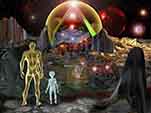: I think I'll pass!
: ~NightSky
: By Michael Snyder
: Are you ready to “eat the bugs”? For a long time, we have been
: told that “eating the bugs” is just a “conspiracy theory”,
: but as you will see below more than 2 billion people around
: the world already eat bugs on a regular basis. More than
: 2,000 types of edible insects are being consumed, and bug
: ingredients are increasingly being used in common foods
: that we purchase in the grocery stores. In fact, you could
: potentially be consuming products that contain insect
: ingredients without even realizing it. So anyone that tries
: to tell you that “eating the bugs” is a conspiracy theory
: is not being honest with you. The following are 12 facts
: that prove that people all over the globe are already
: “eating the bugs” on a regular basis…
: #1 According to the United Nations, there are over 2 billion
: people that eat insects as part of their normal diets right
: now…
: More than 2 billion people worldwide consume insects
: regularly, according to the United Nations, which a decade
: ago began pushing pests as a sustainable super-protein for
: humans, pets, and livestock that can benefit the
: environment and create jobs in developing countries.
: #2 A report that was recently published in a major scientific
: journal says that 2,205 different kinds of insects are now
: being consumed all over the globe…
: A 2024 report titled “The global atlas of edible insects:
: analysis of diversity and commonality contributing to food
: systems and sustainability,” has identified 2205 species
: consumed across 128 countries. Published in the science
: journal Nature, it notes that Asia has the highest number
: of edible insects (932 species), followed by North America
: (mainly Mexico), and Africa. The countries with the highest
: consumption of insect are Mexico (452 species), Thailand
: (272 species), India (262 species), China (235 species),
: and Japan (123 species).
: #3 According to CNN, Singapore has just approved 16 different
: types of edible insects “for sale and consumption”…
: Singapore’s state food agency has approved 16 species of
: edible insects for sale and consumption in the country,
: according to a July 8 public circular addressed to food
: traders.
: “With immediate effect, SFA will allow the import of insects
: and insect products belonging to species that have been
: assessed to be of low regulatory concern,” the Singapore
: Food Agency (SFA) said in its release.
: Insects approved by the SFA include locusts, grasshoppers,
: mealworms and several species of beetle. “These insects and
: insect products can be used for human consumption or as
: animal feed for food-producing animals,” SFA said, adding
: that insects could not be “harvested from the wild.”
: #4 The largest insect farm in the entire world is located in
: France…
: In Europe, France is the center of European insect farming for
: animal and plant feed; a biotechnology company, InnovaFeed
: owns the world’s largest insect farm at 55,000 sqm that
: produces 15,000 tons of protein a year.
: #5 In April 2024, InnovaFeed opened an absolutely enormous
: “research and innovation center focused on insects” in
: Decatur, Illinois…
: More recently, in April 2024, Innovafeed inaugurated its first
: research and innovation center focused on insects in North
: America: the NAIIC (North American Insect Innovation
: Center), with the presence of Illinois Governor JB
: Pritzker.
: #6 An app that allows Germans to scan food products at the
: grocery store indicates that a whole host of things that
: Germans regularly eat have bug parts in them…
: A German app called Insekten Scanner scans the barcode of a
: food product to tell you whether it includes insect parts
: in the ingredients. The app, which was first developed in
: late 2023 and now has over 100,000 downloads, recently went
: viral on X after several viral posts caused outrage among
: Americans.
: The account Wall Street Silver (@WallStreetSilv) posted a
: video on May 2 of a user in a German supermarket scanning
: items with the app, which they captioned “‘We will NOT eat
: the bugs’ has become reality.”
: In the video, the user repeatedly receives the message
: “Insekten Gefunden” or “Insects Found.” Items include
: pudding cups, premade meals, and even chocolate candies.
: “Everything has bugs,” one user replied.
: #7 The very first “insect restaurant” in the United Kingdom is
: getting a lot of attention for the very unique dishes that
: it is offering to customers…
: Grub Kitchen in Wales, the United Kingdom’s first insect
: restaurant, focuses on sustainability and is the vision of
: chef Andy Holcroft. The menu ranges from minced insect
: Bolognese to mealworm hummus and mixed insect pakoras fried
: with vegetables and served with mango chutney. Grub Kitchen
: largely has good reviews on TripAdvisor, but one reviewer
: was sceptical of eating insects, writing: “If this is the
: future, kill me now.”
: #8 There are numerous websites that now offer insect-based
: products to U.S. consumers. One of those websites claims
: that “crickets contain 10 times more vitamin B12 than
: beef”…
: Different types of insects contain different amounts of
: nutrients, but they tend to be dense in protein, iron and
: calcium among other nutrients.
: MightyCricket, a US-based website that sells cricket powder,
: says crickets contain 10 times more vitamin B12 than beef.
: #9 It is being reported that Thailand already has over 20,000
: insect farms…
: According to the Trade Policy and Strategy Office, Thailand
: can produce over 7,000 tonnes of economic insects annually.
: Thailand has more than 20,000 insect farms, especially
: cricket farms, the office said.
: #10 In one region of India, silkworms are so popular that they
: are “available at every market”…
: Silkworms are considered a delicacy in some northeastern
: states of India. In Nagaland, a state on the Myanmar
: border, silkworms are available at every market. Known as
: “eri puka” in Nagamese, the silkworms are fried, tossed
: together with spices, vegetables and bamboo shoots. Crispy
: fried grasshopper is also a common snack in the state.
: #11 Here in the United States, more than 2 million taxpayer
: dollars were spent to create “the Center for Environmental
: Sustainability Through Insect Farming”…
: In 2021 the U.S. National Science Foundation awarded Texas A&M
: and two other universities a $2.2 million grant to
: establish the Center for Environmental Sustainability
: Through Insect Farming. Sixteen multinational companies,
: including Mars and Tyson Foods, also joined as member
: organizations.
: #12 Insect protein has become a multi-billion dollar industry
: in North America, and it is being projected that it will
: experience tremendous growth during the years ahead…
: The North American insect protein market was valued at nearly
: $48 billion in 2023, according to Data Bridge Market
: Research. It’s projected to reach over $274 billion by
: 2031.
: Are you starting to get the picture?
: It won’t be too long before bug parts are in most of our
: processed foods, and they aren’t even trying to hide what
: they have planned. The following comes from a Bloomberg
: editorial entitled “You Will Eat Bugs — and Like It”…
: Picture this: It’s the year 2093. Your great, great
: grandaughter is hosting a dinner party for her friends
: tonight in honor of the total solar eclipse. She starts on
: the bug board, taking care to assemble the tinned locusts.
: The hot honey hornets are next. After that, it’s the
: scorpion kimchi and the ant guacamole. Then she takes the
: baked casu martzu — a Sardinian cheese that contains live
: insect larvae — out of the oven and tops it with faux
: caviar. Wanting to keep dessert simple, she drone-ordered
: some Micolino’s ice cream. Guests can top it with cricket
: sprinkles if they want.
: Of course this fictional scenario will never become reality.
: No matter how many insect farms they set up, it will only make
: a very small dent in the nightmarish global famines that
: are coming.
: Numerous long-term trends are combining to create a “perfect
: storm” for global food production that is unlike anything
: that has ever been witnessed in all of human history.
: So they can keep trying to encourage everyone to eat bugs all
: they want, but in the end it really isn’t going to make
: much of a difference.
: Michael’s new book entitled “Chaos” is available in paperback
: and for the Kindle on Amazon.com, and you can subscribe to
: his Substack newsletter at michaeltsnyder.substack.com.
........................
The only way I'll knowingly eat a bug is if the turkey I cook ate it first!
That said, I haven't heard Michael Snyder for ages, thanks for reminding me of him.







































